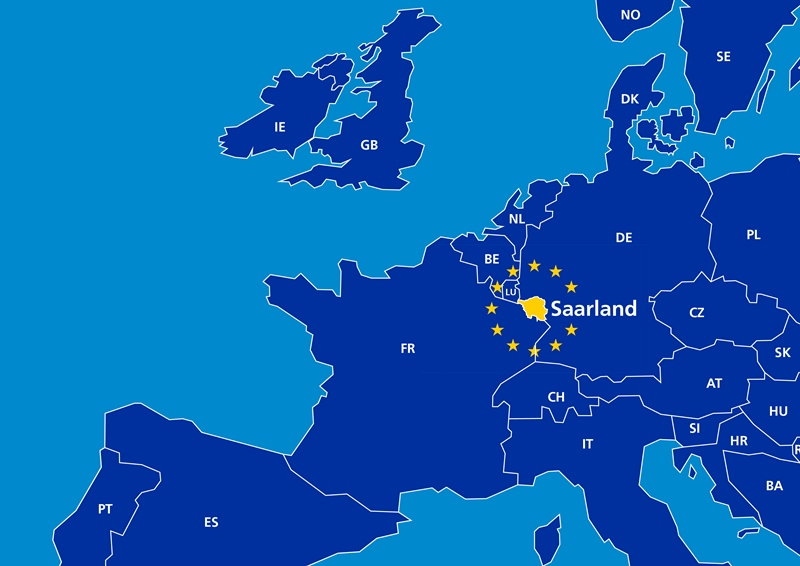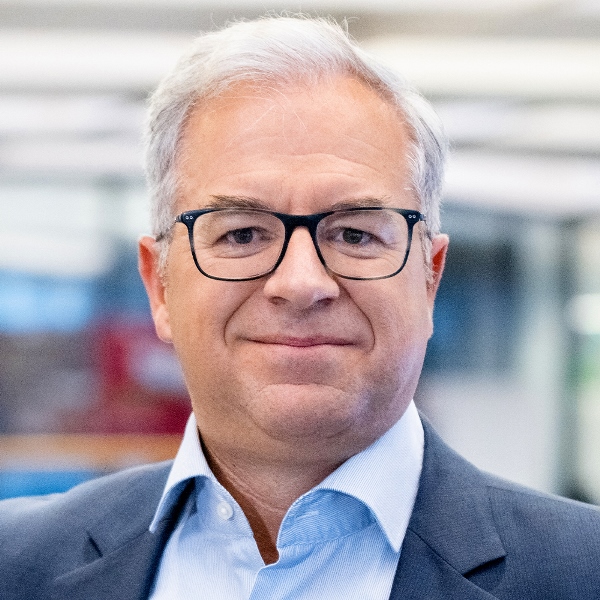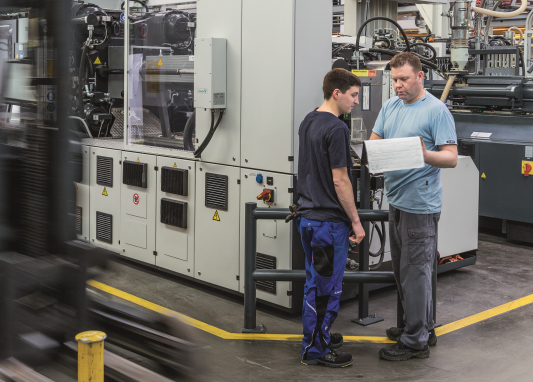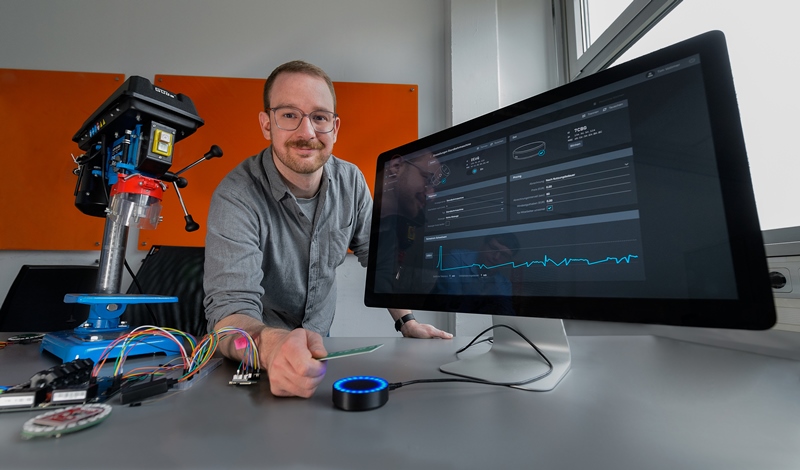Control and analysis in the era of Industry 4.0
A traditional company with a broad perspective: whether intelligent houses or smart factories, pioneering projects need intelligent, electrical control. Saarland’s Hager Group has solutions to suit. A start-up that reads your power signature: what do you do if your machinery pool hails from the pre-network era, so it is not IoT-capable? The start-up 2log, also from Saarland, has a solution.
Developing Industry 4.0 approaches in as targeted a way as possible requires more than just a strong IT landscape with a command of artificial intelligence and cybersecurity. It also requires an industry that is open to innovation. Saarland is a traditional industrial hub that built up research and development skills in IT at an early stage. The region boasts high levels of competence thanks to the Saarland University, the German Research Center for Artificial Intelligence (DFKI), two Max Planck Institutes for Informatics and Software Systems, and the CISPA Helmholtz Center for Information Security. In close collaboration with local companies, they develop products and strategies that have had an impact well beyond the borders of Germany’s smallest federal state.
To ensure that companies do not only benefit from an excellent research landscape and an associated supply of young talent but also other ideal conditions, gwSaar Saarland Economic Promotion Corporation has developed industrial sites and commercial properties to meet all needs. The economic promoter also looks after all parts of the relocation process for new companies, including networking with local stakeholders.
We spoke to two Saarland companies who view Industry 4.0 as not just a buzzword, but rather a tool enabling efficiency and customer-oriented production.

Germany’s Saarland – an industrial hub that wins companies over with its central location
Hager Group
The Hager Group offers solutions and services for electrotechnical installations in residential, industrial and commercial properties.
Its core business ranges from power distribution to cable routing to intelligent building control and security technology. The Hager Group covers the brands Hager, Berker, Bocchiotti, Daitem, Diagral, Efen and Elcom.
The company is continually developing innovative solutions for the control requirements of the key technological advances of our time, such as charging stations for electromobility, assistance solutions to support everyday life, and technologies for an intelligent home.
This Saarland-based company is a European company (Societas Europaea, SE). The Hager Group sets great store by cultural diversity and its European roots.
The company is active across the globe with 11,500 employees and achieved a turnover of 2.19 billion euros in 2019.
Interview: Dr. Ralph Fürderer, CTO, Hager Group

Dr. Ralph Fürderer, CTO, Hager Group
Question: What does intelligent production mean at Hager and what are the benefits?
Dr. Ralph Fürderer: At the Hager Group, the digitalisation of industrial processes – or Industry 4.0 – is approach designed to supplement improvements to our overall efficiency.
It is in particular a way of boosting added value for our customers, but it can also improve business performance in terms of the quality, competitiveness, flexibility and transparency of our production and information flows. We do not follow trends, but rather make targeted use of the opportunities available.
Let me explain: to us, Industry 4.0 does not mean just selectively incorporating new technologies such as additive processes (3D printing), collaborative robots or interactive data glasses into the production process. It is about linking up systems and machinery and seamlessly connecting digital information flows with the reality of production processes.
Targeted data analysis and the use of artificial intelligence improve the performance of our production flows for the long term. This means that new technologies promote the implementation of our end-to-end vision as part of Industry 4.0.
One good example of this is the digitalisation of our maintenance activities:
- Networked tablets are already supporting preventative maintenance.
- Tools, machinery and systems exchange operational data in real time.
- Cloud platform strategies in particular enable the exchange of information with our partners and service providers.
- AI functions identify immediate spare parts needs and directly trigger the ordering process.
- Big data analytics will increasingly form the foundation of future predictive maintenance activities.
Question: Is your company pursuing a clear Industry 4.0 strategy?
Dr. Ralph Fürderer: The topic of Industry 4.0 is a broad and fragmented one, with new innovations virtually every day.
In this context, it is important not to get lost in the plethora of opportunities, but rather to focus on a clear strategy.
The aim of our strategy is to create visible added value for our customers. For us, this in particular means that our production processes need to be as efficiently designed as possible, from brainstorming right through to rollout. What does this actually mean?
- Brainstorming: We collate internal requirements and compare these with the opportunities offered by Industry 4.0.
- Options: We check which solutions best help us to achieve our goals.
- Development: We integrate new solutions into the existing environment, adapted to our standards.
- Rollout: We analyse the implementation process and decide whether to use this solution at all of our sites.
- Learning factory: We continuously evaluate our results and improve our technology base.
Question: You mentioned a ‘learning factory’. Does the factory make mistakes? If so, how is the learning process managed?
Dr. Ralph Fürderer: From our perspective, a ‘learning factory’ is based on a seamlessly digitalised manufacturing process. This begins with raw material provision and is configured based on the aforementioned principles of Industry 4.0 right through to the finished product.
We learn by testing innovations in advance on a smaller scale before they are put to use in large-scale activities. We of course also make mistakes during this process, but these can be remedied in agile and lasting form in a controlled pilot environment.
At this point, let me highlight the vital role played by our employees in the industrialisation and ultimate use of Industry 4.0 technologies. Our colleagues’ knowledge is absolutely crucial: without their flexibility and skills, we would not be able to implement any learning production processes whatsoever.
This means that in a smart, learning factory, mechanical facilities and systems are interlinked via modular devices and IoT components. These intelligent devices and applications enable industrial installations to learn and continually improve their processes. Ultimately, it is a matter of gathering process data and intelligently evaluating it within a short period of time, so that we can continuously optimise our processes and provide our customers with the best possible service.

The learning factory has become reality at the Hager Group
Question: You won awards with your Tool Management 4.0 project. Have you since set up further processes and tasks based on the principle of Industry 4.0?
Dr. Ralph Fürderer: Our Industry 4.0 ‘Tool Management’ project in 2014 made us the first industrial company in this environment, and even then we were performing vertical and horizontal integration of machinery, sensors, processes and systems. Our digital tool management gives our employees the opportunity to understand new technologies and identify their benefits for the company.
This project formed the basis for the Hager Group’s current digital Industry 4.0 application infrastructure. In recent years, we have been continually further digitalising our manufacturing processes and deploying them across various production sites.
Question: Saarland is home to the German Research Center for Artificial intelligence (DFKI) and other renowned IT research institutes. DFKI is one of the birthplaces of Industry 4.0. Does your company benefit from this research expertise in Saarland?
Dr. Ralph Fürderer: The Hager Group has been working closely with local institutions such as DFKI, HTW Saar and the August-Wilhelm Scheer Institute for many years.
We have implemented various projects with our partners in this innovative environment. Examples include a project on the neural networks of real-time facial recognition (2018 in DFKI), energy management for a new Hager Group building in Blieskastel (2017 with the August-Wilhelm Scheer Institute), and the ‘Liongrid’ project on the virtual energy plan (2017 with Scheer and HTW Saar).
Our group was also a founding member of the East Side Fab in Saarbrücken, a network of regional stakeholders from business, science and related areas.
Projects that are currently underway or in the pipeline include the ‘SUITE’ project for adaptive support based on artificial intelligence (with DFKI), the ‘Flexchain’ project for providing flexibility to consumer-side networks (with the August-Wilhelm Scheer Institute and Stadtwerke Saarlouis), and the ongoing application to the Ministry of Economic Affairs (BMWi) for the ‘ELIAS’ project covering the automatic linking of electric vehicles with charging infrastructure, in conjunction with East Side Fab, DFKI and HTW Saar.
Question: The Hager Group is active all over the world. Does Saarland offer benefits thanks to its location near the French border?
Dr. Ralph Fürderer: The Hager Group operates all over the world and makes use of local expertise. Our local focus is therefore as relevant as our global one. Some employees at our German site in Blieskastel are French. Similarly, we also have German colleagues at our Obernai site. As our roots are French and German, we have strongly internalised this culture. This also provides easier access to partners in business, science and other areas in both countries.
The Hager Group is therefore the only company in its competitive environment to occupy such a strong market position in both Germany and France.
2log.io
This company, established in 2019, provides IoT capability to anything with a plug. 2log.io views itself as an Industry 4.0 transformation partner, particularly for SMEs in the manufacturing industry.
With their smart meter, 2log switch, and RFID registration option, they offer soft, safe and cost-effective access to Industry 4.0.
Customers enjoy maximum configuration options, not least thanks to open interfaces.
Interview: Tim Vollmer, CEO, 2log.io

CEO Tim Vollmer demonstrates how the 2log.io system makes any machinery pool IoT-capable using plug and play
Hardware and software developed in-house by the Saarland start-up
Question: Mr Vollmer, 2log.io makes existing machinery compatible with Industry 4.0. What is your approach to doing this?
Tim Vollmer: We wondered why companies were not making use of Industry 4.0. A survey undertaken by the German digital association Bitkom cited the three biggest obstacles for SMEs as being high investment requirements, a lack of staff to maintain systems, and IT security worries. These legitimate concerns have meant that only 16% of companies with fewer than 100 employees make use of sensor data and big data.
We wanted to become a transformation partner for these companies and create a system that would allay these concerns. Key priorities in this were that it should be possible to integrate existing machinery pools, and that there should be no changes to the machinery itself to avoid voiding warranties and guarantees.
Question: How does the 2log.io system work?
Tim Vollmer: The lowest common denominator for all machinery is the power source. We therefore developed a smart meter called the 2log switch which is integrated into the power supply. At 230V this just requires an adapter plug, whilst 400V devices get a larger switch unit. We use the smart meter to record the power supply to individual machines, and the system then transmits this data to the cloud via WLAN. It can also switch off the power, offering both analysis and control capabilities.
Question: So you record the power supply. What information can you derive from these values?
Tim Vollmer: Power consumption values are an extremely potent source of information, because we can use the specific power signature to understand what the machine is doing. Take the example of monitoring an automatic coffee machine – you can use the power signature to precisely identify whether the drink being made is a black coffee, a milk coffee or an espresso. So a relatively simple pattern assignment enables us to identify what is being produced. This can be transferred to industrial machinery one-to-one, and we can precisely identify what recorded machinery has processed.
However, we are also interested in who is working on a machine or what project the machine is being used for, so we developed a smart RFID reader that controls access to the machinery. Users sign on via an authorisation system using their smartphone or an access card.
Question: What do you see as potential applications?
Tim Vollmer: The power supply also serves as a very generalisable interface, and thus provides a generalisable sensor value. Companies can be creative when it comes to developing analytic scenarios, deciding what data to record from their particular production environment and what analyses they want to perform. This means that there is a wide variety of potential applications. Let me offer you a few examples.
The system learns to recognise the power signatures of programs that run in an increasingly standardised way, and is able to detect anomalies. For example, changes can provide information about whether maintenance is required, or the probability of a particular component failing. It is therefore ideal for small-batch manufacturing.
As all access is logged, machine operation times can be clearly assigned to users or even projects. We have established our own cloud system, enabling us to address virtually all interfaces. In other words, recorded times can be automatically passed on to a goods management system such as SAP, and then posted and billed to the relevant project.
Assignment to individual users can also ensure safety at work – employees without training cannot even switch the machinery on.
The big data recorded can of course be used to develop entirely new areas of business. For example, machinery manufacturers can adapt their maintenance schedule to meet actual needs and prevent production losses.
Question: Despite the attractions of other locations, 2log opted for Saarland. What are the benefits of this location?
Tim Vollmer: Saarland is not yet ‘overrun’ by start-ups. We get very individual support here, as well as easy access to funding instruments. Our fixed costs (such as office space) are lower than in well-known start-up hotspots in German metropolises. In addition, Saarland University trains excellent computer scientists, making it very easy for us to find good workers interested in start-ups.
Author:
Anja Petschauer
Marketing Director
gwSaar Saarland Economic Promotion Corporation
a.petschauer@invest-in-saarland.com
Your Germany’s Saarland contact in Turkey:
(Ms.) Derya Araç
Temsilci gwSaar Türkiye / Representative gwSaar Turkey
gwSaar Saarland Eyaleti Resmi Ekonomik Kalkınma Şirketi
M: +90 / 531 958 83 88